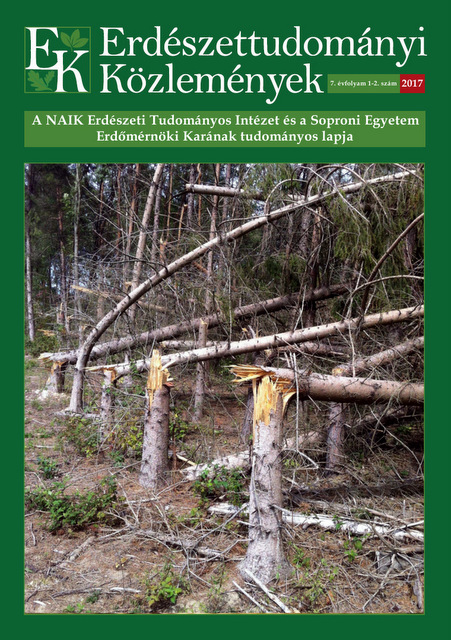| 1. | Andrési D., Kálmán K., Andrésiné Ambrus I. & Lakatos F. 2015: Adatok az ásotthalmi Tanulmányi erdő futóbogár faunájához (Coleoptera: Carabidae). In: Lipák L. (ed): Alföldi Erdőkért Egyesület Kutatói Nap XXIII.: Tudományos eredmények a gyakorlatban, 89–95. |
| 2. | Bali L., Szinetár Cs., Andrési D., Kámpel J. & Tuba K. 2016a: Mesterségesen kialakított lékek talajközelben élő pókfaunájának (Araneae) vizsgálata. Növényvédelem 52(6): 287–296. |
| 3. | Bali L., Szinetár Cs., Andrési D., Tuba K. & Kálmán K. 2016b: Ritka és védett pókfajok előfordulása az ásotthalmi tanulmányi erdő területéről In: Lipák L. (ed): Alföldi Erdőkért Egyesület Kutatói Nap XXIV.: Tudományos eredmények a gyakorlatban, 43–48. |
| 4. | Barber H. S. 1931: Traps for cave-inhabiting insects. Journal of the Elisha Mitchell Scientific Society 46: 259–266. |
| 5. | Bray J. R. & Curtis J. T. 1957: An ordination of the upland forest communities of Southern Wisconsin. Ecological Monographs 27: 325–349. DOI: 10.2307/1942268 |
| 6. | Buchar J. & Růžička V. 2002: Catalogue of Spiders of the Czech Republic. Peres Publishers, Praha, 17–189. |
| 7. | Ferris R., Peace A. J. & Humphrey J. W. 2000: Relationships between vegetation, site type and stand structure in coniferous plantations in Britain. Forest Ecology and Management 136(1-3): 35–51. DOI: 10.1016/s0378-1127(99)00268-6 |
| 8. | Gallé R. & Torma A. 2009: Epigeic spider (Araneae) assemblages of natural forest edges in the Kiskunság (Hungary). Community Ecology 10(2): 146–151. DOI: 10.1556/ComEc.10.2009.2.2 |
| 9. | Gallé R., Maák I. & Szpisjak N. 2014: The effects of habitat parameters and forest age on the ground dwelling spiders of lowland poplar forests (Hungary). Journal of Insect Conservation 18(5): 791–799. DOI: 10.1007/s10841-014-9686-9 |
| 10. | Gnelista V. A. 2008: A survey of Crimeran Lyniiphidae (Araneae). 1. On seven rare and little known lyniiphids from Crimea. Arthropoda Selecta 17(3-4): 191–202. |
| 11. | Greenstone M. H. 1979: A line transect density index for wolfspiders (Pardosa spp.), and a note on the applicability of catch per unit effort method to entomological studies. Ecological Entomology, 4(1): 23–29. DOI: 10.1111/j.1365-2311.1979.tb00558.x |
| 12. | Halász G. (ed) 2006: Magyarország erdészeti tájai. Állami Erdészeti Szolgálat, Budapest, 154. |
| 13. | Hänggi A., Stöckli E. & Nentwig W. 1995: Habitas of Central European Spiders. Miscellanea Faunistica Helvetica 4, 459. |
| 14. | Horváth R., Magura T., Szinetár Cs. & Tóthmérész B. 2009: Spiders are not less diverse in small and isolated grasslands, but less diverse in overgrazed grasslands: A field study (East Hungary, Nyírség). Agriculture Ecosystems & Environment 130(1-2): 16–22. DOI: 10.1016/j.agee.2008.11.011 |
| 15. | Horváth R. 2012: Az urbanizáció hatása erdei talajlakó pókokra. Természetvédelmi közlemények 18: 224–233. |
| 16. | Jaccard P. 1912: The distribution of the flora in the alpine zone. New Phytologist 11: 37–50.
DOI: 10.1111/j.1469-8137.1912.tb05611.x |
| 17. | Kádár F. & Samu F. 2006: A duplaedényes talajcsapdák használata Magyarországon. Növényvédelem 42(6): 305–312. |
| 18. | Kálmán K. 2016: Futóbogár-együttesek vizsgálata az ásotthalmi Tanulmányi erdőben. Szakdolgozat, Nyugat-magyarországi Egyetem, Erdőművelési és Erdővédelmi Intézet, Sopron. |
| 19. | Kiss B. & Samu F. 2000: Evaluation of population densities of the common wolf spider Pardosa agrestis (Araneae: Lycosidae) in Hungarian alfalfa fields using mark-recapture. European Journal of Entomology 97(2): 191–195. |
| 20. | Loksa I. 1972: Pókok II – Araneae II. Fauna Hungariae 109: 112. |
| 21. | Maelfait J.-P. & Hendrickx F. 1998: Spiders as bioindicators of anthropogenic stress in natural and semi-natural habitats in Flanders (Belgium): some recent developments. In: Selden P. A. (ed): Proceedings 17th European Colloquium Arachnology, 293–300. |
| 22. | Palmgren P. & Lönnqvist B. 1974: The spiders of some habitats at the Nåtö Biological Station (Åland, Finland). Commentationes Biologicae 73., Sociezas Scientiarum Fennica, Helsinki, 1–10. |
| 23. | Podani J. 1997: Bevezetés a többváltozós biológiai adatfeltárás rejtelmeibe. Scientia Kiadó, Budapest, 252–257. |
| 24. | Renkonen O. 1938. Statisch-ökologische Untersuchungen über die terrestrische Käferwelt der finnischen Bruchmoore. Annales Zoologici Societatis Zoologicae-Botanicae Fennicae ’Vanamo’ 6: 1–231. |
| 25. | Rényi A. 1961: On measures of information and entropy. Proceedings of the fourth Berkeley Symposium on Mathematics, Statistics and Probability: Held at the Statistical Laboratory, University of California, June 20-July 30, 1960, 547–561. |
| 26. | Shannon C. E. & Weaver W. 1949: The Mathematical Theory of Communication. University of Illinois Press, Urbana and Chicago, 1–117. |
| 27. | Szinetár Cs. 2006: Pókok. Keresztespókok, farkaspókok, ugrópókok és rokonaik a Kárpát-medencében. Élővilág Könyvtár, Kossuth Kiadó, Budapest. |
| 28. | Szinetár Cs., Kovács P., Samu F. & Horváth R. 2006: Egy kisparcellás lucernaföld talajlakó pókfaunája és annak szezonális változásai a Nyugat-Dunántúlon. A Berzsenyi Dániel Főiskola Tudományos Közleményei XV. Természettudományok, 10: 69–79. |
| 29. | Szinetár Cs., Erdélyi F. & Szűts T. 2011: Pókfaunisztikai vizsgálatok a nagykőrösi pusztai tölgyesek területén. In: Verő Gy. (ed): Természetvédelem és kutatás a Duna-Tisza közi homokhátságon - Tanulmánygyűjtemény. Rosalia 6. Duna-Ipoly Nemzeti Park Igazgatóság, Budapest, 209–221. |
| 30. | Wise D. 1993: Spiders in Ecological Webs (Cambridge Studies in Ecology). Cambridge University Press, Cambridge, 1-289. DOI: 10.1017/CBO9780511623431 |
| 31. | Woodcock B. A. 2005: Pitfall trapping in ecological studies. In: Leather S. (ed): Insect Sampling in Forest Ecosystems. Blackwell, Oxford, 37-57. DOI: 10.1002/9780470750513.ch3 |
| 32. | 100/2012. (IX. 28.) VM rendelet - A védett és a fokozottan védett növény- és állatfajokról, a fokozottan védett barlangok köréről, valamint az Európai Közösségben természetvédelmi szempontból jelentős növény- és állatfajok közzétételéről szóló 13/2001. (V. 9.) KöM rendelet és a növényvédelmi tevékenységről szóló 43/2010. (IV. 23.) FVM rendelet módosításáról. (2017. május) URL |
| 33. |
|
